|
The Dolman Manor
Royal/Meaux/Percy/Bishop/Dolman/Denison/Duncombe
|
|
In 1673, the hearth tax shows a Robert Dolman esq. had 11 hearths, with the next biggest being Mr Plaxton Snr. with 9. Robert Dolman was awarded 503 acres, 2 roods and 37 Perches in the enclosure of 1759. This was the largest award of the 94 individuals mentioned. In 1760 half the Dolman land was in tillage and the other half in grass. By 1749, the Dolman's were in debt and a number of acts were passed (see below) allowing sale of the old Royal Manor, Many of the debtors were Pocklington tradesmen, some of which had threatened Dr.Dolman and his servants. The final act was passed in 1776 allowing the whole manor to be sold. Although there were two sale notices printed in newspapers in 1780 & 1787 (see below), Robert Dolman and his trustees still held the Manor until his death in Liege, Belgium, in February 1792, after which it was sold under instruction of his son Thomas*, to Robert Denison of Kilnwick Percy.
* Ref: Dugdale's visitation of Yorkshire |
|
| |
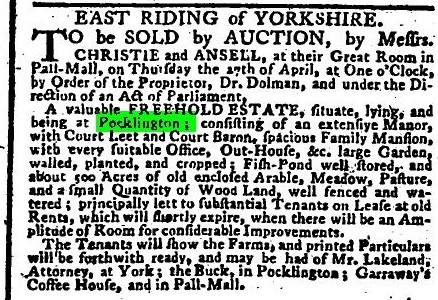 |
From: St. James's Chronicle or the British Evening Post March 28, 1780 |
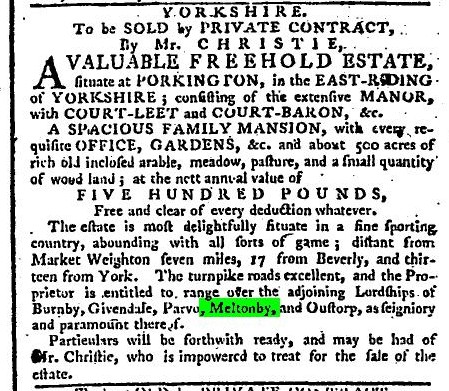 |
From: Gazetteer and New Daily Advertiser, April 7, 1787 |
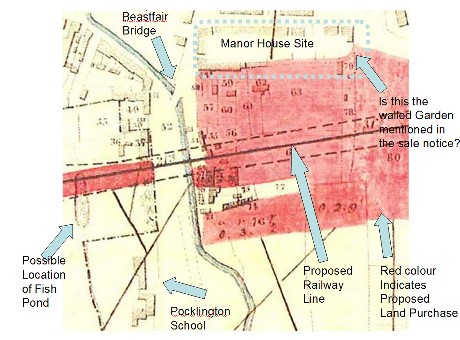 |
This Map was drawn around 1845 to plan the proposed railway.
It shows remnants of what is called the Manor House on Watson's map. It was possibly the house of the Steward of the Manor. The Steward would have looked after the fairs and markets from this location. In fact, it is perfectly placed to do that job. The house forward faced West Green where the fairs would be held and then backs on to the Market Place where the Saturday Markets would be held. A perfect location to collect all the various rents and tithes from the markets
|
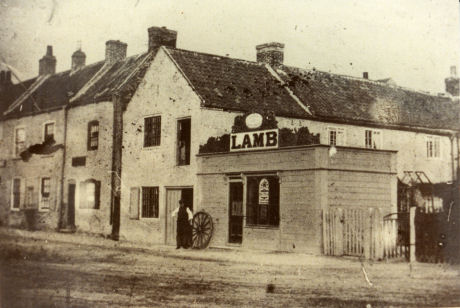 |
| A very old photograph showing the 'Manor House' (as Watson labelled it) in Railway Street as occupied by the Lamb Family who were plumbers, painters and glaziers. The Manor house faces West Green where the fairs were held. |
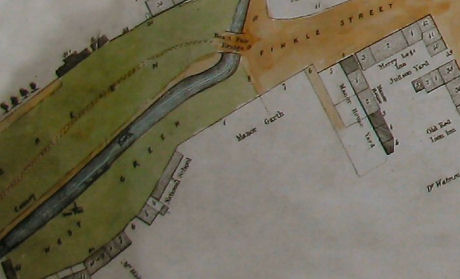 |
Watson's map of 1844 shows where he thought the Manor House was. |
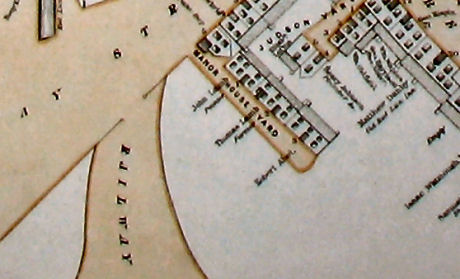 |
Watson's map of 1855 (post railway) |
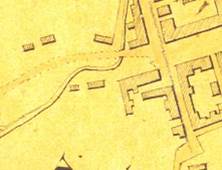 |
1816 Canal Map |
 |
Aerial photo |
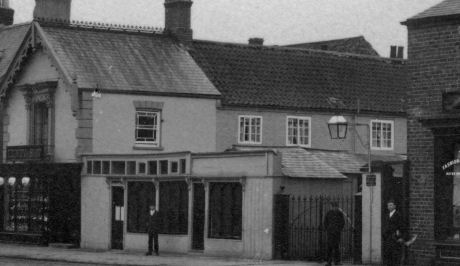 |
The old 18th century windows can be seen on the Manor House |
 |
Present day remnant of the manor house |
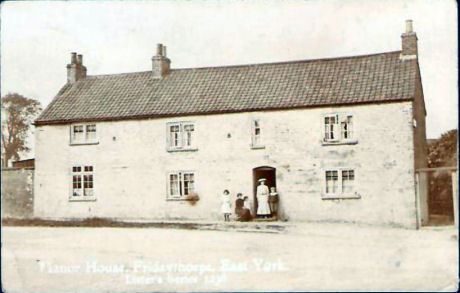 |
Fridaythorpe Manor House was the same style as Pocklington |
| |
In the Deeds Registry (Ref:BQ 564 851) for 3/4 Sept. 1792, a lease & release is made between William Pollard* of Mitcham, Surrey in the first part, and Josiah Prickett** of Hull (trustees of the Dolman Estate) in the second part and Robert Denison*** of Kilnwick Percy of the third part concerning the Manor of Pocklington, with all rents amounting to £73-8s-8d. It mentions the capital messuage or mansion house with the yard, garden, orchard, outhouses and appurtenances.
Two closes of arable meadow or pasture ground called Dove Butts
White Mill closes containing 11 acres & 3 roods - tenant Mr. Nichol
Two closes called Brick Kiln closes containing 13 acres & 2 roods
One close called Maunder Land Close containing 4 acres
Four closes called Bishop Croft Closes containing 54 acres
One close called Cawkey Beck Close containing 15 acres
Four closes called Burnby Closes containing 14 acres
Four closes called Sour Toft Closes containing 37 acres
Two closes called Swann Closes containing 6½ acres in the occupation of Robert Waltham
Three closes called Beckland Closes containing 33 acres
One little close called Paddock
Three closes called Underwood Closes containing 13 acres
Two closes called Middle Closes containing 11 acres
One close called Browgate containing 12 acres and 3 roods
Three closes called Brants containing 14 acres in the occupation of Sarah Smith widow
Two closes called Beckland closes containing 28 acres and 2 roods
One close called Bottoms
One close called Burnby Cross containing 5 acres and 3 roods
Two closes called Longland Closes containing 9 acres in the occupation of John Cross.
A messuage in the occupation of John Ward
A messuage in the occupation of Richard Richardson
A building used by John Ireland as a Blacksmiths Shop
One stable & Kiln Rook now in the occupation of Richard Cross
Two closes called Intacks containing 8 acres and 1 rood
One close called Hill Side close containing 7 acres in the occupation of John Ireland and Robert Wilson
Two closes called Lang Land Closes containing 21 acres and 3 roods
One close called Tweengates containing 7 acres and 3 roods
One garth or piece of ground called the Back Orchard containing 1 acre in the occupation of James Catton
One close called Gore Close containing 1 acre in the occupation of the Reverend McGale
One close calle Foulsike Bottom Close containing 2½ acres in the occupation of John Weddale
One close called White Mill Close containing 11 acres and 3 roods
Five closes called Foulsike Closes containing 44 acres and 3 roods in the occupation of Thomas Clarke
One close called Underwoods containing 6 acres and 1 rood in the occupation of William Pinder
One close called Topwood close containing 5½ acres
Two closes called Scrogwood Closes containing 7 acres and 1 rood in the occupation of Mathias Brown Yeoman
One close called Tenter Row close containing 11 acres and 1 rood
One close called Bottoms close containing 5 acres and 1 rood in the occupation of Matthias Brown carrier
One close called Underwood close containing 2½ acres
One close called Hill Side close containing 5 acres
One close called Tow Mill garth containing 1 acre in the occupation of Thomas Scaife
One close called Hill side close containing 4 acres and 1 rood in the occupation of Mary Easton
All that land lying in a close belonging to Matthias Houlden in the occupation of William Turner
A parcel of ground now or lately used as a Tan Yard and now in the occupation of Robert Wilson.
One close called the Woods containing 10 acres
One close called Beckland Close containing 19½ acres
A close called Underwood Close containing 8 acres
All that close called Clock Mill containing 7½ acres and in the occupation of Joseph Terry or his undertenants
* Pollard and Prickett were possibly trustees of the Dolman estate.
** Believed to be an Attourney in Scale Lane, Hull
*** The Purchaser
n.b. the above is not a transcription, just an extract of the relevant information.
|
From British Private Statutes 1707-1800 |
| Year, Session and Chapter
|
Subject Matter |
| 1749 (23 Geo. 2) c. 26P |
Robert Dolman's estate: raising money for payment of debts |
1765 (5 Geo. 3) c. 91P
(Click this link to see the Act) |
Robert Dolman's estate: sale of part in Pocklington (Yorkshire) for payment of his and his eldest son Robert's debts and for provision for said eldest son and younger children |
| 1769 (9 Geo. 3) c. 83P |
Revoking and making void part of the trusts declared in an Act concerning Robert Dolman's estate (1765 (5 Geo. 3) (c.91P)), declaring other trusts relative thereto, making provision for payment of other debts not provided for by said Act
|
| 1776 (16 Geo. 3) c. 97P |
Robert and Robert (his son) Dolman's estate in Pocklington (Yorkshire): sale and purchasing and settling others |
| |
Royal Manor references |
| Date/Reference |
Subject |
| 1086 Domesday |
In Poclinton (Pocklington) with three berewicks, Haiton (Hayton), Mileton (Millington), Belebi (Bielby) there are at geld twenty-five carucates to be taxed, and there can be 15 ploughs, Morcar held this for one manor. Now the king has there thirteen villeins and five bordars, having five ploughs and four rent payers who render thirty shillings. There is a church and a priest and two mills rendering five shillings. The whole manor four leagues in length and three in breadth. In the time of King Edward it was worth fifty-six pounds, now eight pounds.
To this manor belongs the soke of these lands; Bruna (Nunburnholme) one carucate, Meltebi (Meltonby) eight carucates, Grimtorp (Grimthorpe) four carucates, Mileton (Millington) thirteen carucates, Brunebi (Burnby) one carucate and a half, Aluuarestorp (Allerthorpe) six carucates, Waplinton (Waplington) two carucates, Frangefoss (Fangfoss) eight carucates, Bernebi (Barmby Moor) six bovates; Ghiuedale (Great Givendale) eight carucates, Torp (Ousethorpe?) three carucates. In all there are thirty five and a half carucates of land at geld, and there can be thirty ploughs there. Now in the king's hands there are fifteen burgesses having seven ploughs and a mill rendering two shillings. Moreover, in Chilleuuinc (Kilnwick Percy) there are sixteen carucates of land at geld, where there may be eight ploughs. Of these carucates, six belong to the hall, and ten are in the soke of Pocklington. Pasturable woodland four quarameens in length and as much in breadth. The whole of Chilleuuinc one league in length and half in breadth. |
1122
Farrer: 'Early Yorkshire Charters':
|
Henry I on his Yorkshire tour informs the reeve and minister of Pocklington that he has granted the tithes of Pocklington and Kilham to Hugh Dean of York. |
| 1297 |
INQUISITION taken before John de Lydegraynes at Uluisthorp^ near Pokelington on Friday before Whit-Sunday, 25 Edw. (31 May, 1297), by Nicholas de Clyf, Nicholas de Hothum, Hugh de Linton, James de Millington, Ralph Doway, Adam de Esthorp, Hugh de Colevyle, Henry de Herlethorp, Martin Mauleverer, Elias de Japum, John son of Dionisia, Robert Roulandj Ralph de Frenes, and Robert Dolman. Dionisia, who was wife of Remigius de Pokelington, on the day of her death held nothing of the King in chief, but she held of the heir of Isabel de Fortibus, formerly Countess of Albemarle, having been enfeoffed together with her husband by charters of the Countess
granted to them and the heirs of Remigius. So she held 20 bovates of land in Pokelington, each bovate with meadow and appurtenances, worth by the year los.; a watermill, worth 405. a year; the services of tenants of 21 bovates of land there (the service of each bovate worth 2s. bd.) ; and
rents of two cottars, yearly 2s.; and free courts every three weeks, worth by the year half a marc. She held also by the beforesaid charters in Meltonby four bovates of land, at half a marc each. And so the sum is £16 ys. lod. in all issues by the year.
The said Dionisia held all the said tenements of the heir of the before named Countess by the yearly service of3^. 6d. Roger, her son, is next heir of Remigius and of her, aged forty years and more " |
| |
|
| |
|
| |
|
| |
|
|
|
|

